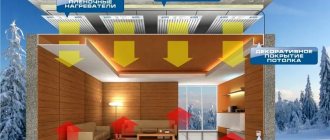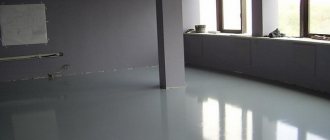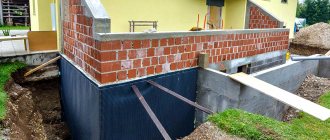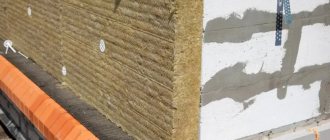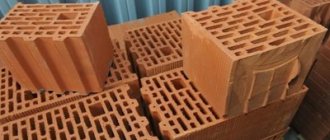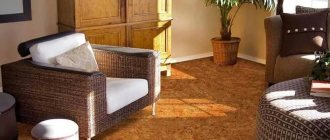Creating walls from foam means quickly, cheaply and effectively providing thermal insulation for your home. Modern manufacturers allow you to use either ready-made foam panels or spray foam from a special spray bottle or can onto the surface. Let's consider the main pros and cons of the methods, what types of materials are used for this today, on what surfaces and how they can be applied, as well as how to use these technologies with your own hands and what is required for this.
External house insulation PPU Source ppuspb.ru
How to insulate a house and why - insulation for a house without consequences
Why do our clients order ecofoam insulation? What exactly motivates them not to use traditional insulation? The picture, as always, is very simple. An example from one of our clients (we filmed a whole video story under this post): the house was initially insulated with mineral wool. After insulation, it was discovered that the cotton wool was getting wet. This became especially noticeable when the walls were plastered. The customer decided to dismantle the mineral…
Advantages
Ecopena from Aisinin has a unique property: it almost instantly fills even the smallest cracks and cracks in buildings and structures, expanding a hundred times in a matter of seconds, thereby blocking all possible drafts and leaks of warm air in winter and cool air in summer
To understand the full degree of waterproofing of this innovative material, it is enough to compare a high-quality windproof jacket with a wool sweater. Despite all the lightness, the jacket will perfectly retain body heat and will not leave the wind a single chance. A sweater, despite the warmth of the material itself, is absolutely defenseless against air movement, regardless of thickness: the wind easily penetrates through the weave of the threads, and the person becomes cold.
The same principle applies to eco-foam: it reliably blocks external cold in winter or heat in summer, maintaining a comfortable indoor temperature. Other traditional insulation materials (mineral wool, various foam plastics) leave a lot of unfilled voids and cracks; there is no sealing, since it is impossible to avoid technological joints during installation. This means that leaks of warm air in winter and cool air in summer are inevitable, which directly entails an increase in the cost of utilities. Living and working in a windswept home is very expensive today, and with ever-increasing energy prices, it will become prohibitively expensive tomorrow.
Thanks to the tightness of ecofoam from Aisinin, our company also guarantees the balance of humidity in the room: after insulation work, the climate in your home will improve. Ecofoam does not absorb or retain water like other insulation materials, which is extremely important if the roof leaks. The foam itself has vapor permeability similar to that of wood, which means that excess moisture will not accumulate in the house, and there will be no mold or dampness.
After application, ecofoam serves as excellent protection not only from wind and moisture, but also from dust. What is also important: according to the results of studies conducted by the Fraunhofer Institute, when using eco-foam from Aisinin, no additional vapor barrier is required. Thanks to the vapor permeability of ecofoam, walls can breathe. All of the listed properties are preserved for decades - Aisinin does not shrink, is not blown out and does not sag.
Let’s add: ecofoam from Aisinin can easily cope with the most difficult tasks, providing an airtight barrier to air and moisture in the most inaccessible places. That’s why this material is used for complex restoration work. The listed properties of ecofoam extend the life of many ancient buildings. This special material has no analogues for the restoration of domed roofs in various religious buildings: it is simply impossible to hermetically insulate the roof of an ancient Gothic or Orthodox church using other technologies.
The structure and functional characteristics of Aisinin thermal insulation foam are unique: the material provides almost one hundred percent thermal insulation, quickly and firmly adheres to any surface, and is capable of absorbing noise. At the same time, moisture does not accumulate in the rooms, and condensation does not form on the walls and ceilings. Aisinin’s formula is water-based, which makes it possible to use foam for insulating residential premises without any health consequences. Aisinin is used for thermal insulation of roofs, attics, ceilings, walls, floors, plinths and foundations. Seamless installation makes it possible to carry out insulation work in rooms of any size and configuration throughout the year, that is, even in winter.
Characteristics of Aisinin thermal insulation foam
The type of thermal insulation foam is selected depending on the type of work and the material from which the house is built.
When conducting research and tests that always accompany the production of building and finishing materials, it turned out that Aisinin insulation is also an excellent sound insulator. The tightness of the foam and its properties help muffle vibrations and block street noise.
According to the results of studies carried out by CSTB (reports AC 12 26041158/1 and 12 26041158), the acoustic properties of Aisinin H2 Foam Lite (LD-C-50) significantly exceed the standard curve, especially in the mid-range audio frequency range above 400 Hz with RA,tr values up to 48 dB (for walls with wooden frames) and up to 77 dB (for concrete walls).
Simply put, ecofoam from Aisinin is a multifunctional product that does an excellent job of both insulation and noise protection, and precisely in the range of noise that fills our lives every day
If you use Aisinin insulation at the construction stage, you can get not only a warm, but also an extremely comfortable house. Interior partitions can be made from lightweight materials, filled with foam from the inside. This will help to significantly reduce construction costs, while getting a cozy and quiet home.
Good sound insulation is an issue that is relevant for any premises: bedrooms, children's rooms, bathrooms and living rooms. Children will be able to frolic in their room without restrictions, without disturbing parents who are tired after work; the noise from flushing the toilet at night will not wake up sleeping household members; The loud sound of a movie you watch in your home theater won't disturb your family members from reading or talking on the phone in adjacent rooms. If a musician lives in the house, then using Aisinin foam is a simple and inexpensive solution that will help isolate a music studio, maintain peace in the family and improve relations with neighbors who love silence.
Commercial conditions for installing eco-foam are negotiated individually in each case. will offer optimal conditions so that everyone is satisfied: the owner of the house, the architect, and the contractor. You can contact our specialists for a free consultation.
If the height of the ceilings does not allow you to insulate the floor indoors, but the house has a basement, you can carry out work on insulating and sealing the floors by insulating the basement ceiling. The effect will be the same, and there will be more free space in the house! Read more about insulating ceilings here, foundations and basements here.
If the height of the ceilings does not allow you to insulate the floor indoors, but the house has a basement, you can carry out work on insulating and sealing the floors by insulating the basement ceiling. The effect will be the same, and there will be more free space in the house! Read more about insulating ceilings here, foundations and basements here.
This article explains why, when using Eco-foam materials with a special approach to design, you can abandon both the presence of a ventilation gap and a vapor barrier film. In other words, you don't need a roof threshold! And this is a great money saver.
There are two reasons that cause water vapor to penetrate into a fence structure: steam pressure and air movement.
As already mentioned, through vapor-permeable barriers, steam comes out through the process of diffusion and this process is continuous. So it vents into the cold attic, and if the attic is NOT ventilated, it accumulates and condenses inside it. Fortunately, in Ukraine there are very few hermetically sealed attics, so steam easily escapes from the attic space into the surrounding air due to wind and natural draft.
Let's now look at the attic. An attic is a well-insulated attic that is used as a living space. The advantage of the attic is that the entire useful volume of the residential building is used.
The presence of a significant layer of effective insulation reduces the thermal conductivity of the fence, and hence the air temperature in the gap. As the air temperature in the gap approaches the ambient temperature, the rate of air exchange decreases. A decrease in the air exchange rate and a small air gap do not allow large amounts of steam to be removed. Therefore, they try to reduce the amount of vapor coming from the room by diffusion through the attic fence with a vapor barrier film.
It was found that air flow is more responsible for vapor transfer than the diffusion mechanism. Therefore, the most important quality of thermal insulation is its continuity. Only a continuous air barrier can prevent the air from carrying large amounts of moisture.
A coil of air from the house outside carries thirty times more moisture than diffusion, so it is in places of air leaks that moisture condenses and accumulates in building structures. This should be avoided, since most building materials do not tolerate high humidity well, so for thermal insulation with high vapor and air permeability, it is necessary to use a vapor barrier.
Consider Eco-foam. The vapor permeability of this material is only 0.09 mg / (m * Pa * h), which is comparable to the vapor permeability of plywood or dry wood across the fibers. For comparison, the vapor permeability of mineral wool averages 0.3 mg / (m Pa h). Thus, the vapor permeability of the Eco-foam material is very low, due to which the processes of moisture accumulation in such a material are much slower than in cotton insulation.
Air permeability coefficient, kg / Pa ∙ m ∙ h 0.01-0.008 the material completely fills the cavities, leaving no gaps or cracks, creates a strong “breathing” barrier to the movement of cold air, preventing it from entering the room. Open cell technology allows you to control the penetration of moisture into the house, which enters along with the air. Therefore, when using the heat-insulating material Eco-foam in our climate zone, except for rooms with high humidity (saunas, bathrooms, swimming pools), with a special approach to design, you can refuse to have a vapor barrier film.
There are no completely airtight houses. However, a high degree of protection against air leaks is a very important component. The tighter the air barrier, the better. Air insulation not only protects the building envelope, but also protects the house from heat loss, allows better regulation of natural and mechanical ventilation, and also reduces the penetration of allergens and noise from outside.
Source
What is the best way to insulate an attic roof?
Roof insulation Ecopen, PPU, Polyurethane foam There is a huge selection of polyurethane foams on the market and the question often arises: which insulation for a home is better. There are two types of foams: hard foam and soft foam. Their density differs: one foam has a density from 10 to 20 kg/m3, the other has a density from 30 to 60 kg/m3. Solid foam (high-density polyurethane foam) has ...
Which variety to choose
In many ways, the choice will depend on the specific situation and what area needs to be treated. Using an example, we can consider the most common cases when a house needs foam insulation:
- If you need to seal cracks or eliminate any other defects on the surface, then polyurethane is suitable. But such material should not be exposed to sunlight.
- If you need to fill a large volume, then penoizol is suitable. But an ordinary cylinder will not be enough; you will need to purchase a special device with high pressure. You don’t have to buy it at all - you can rent it or borrow it from friends, because no one will use it often.
- If you need to seal small cracks and carry out thermal insulation in small areas, you can buy a cylinder with regular polyurethane foam. It does not support combustion, after hardening it is particularly hard, and it has an ecological composition.
- If defects are found on the outside of the wall, then you need to apply a composition based on polyurethane. It is applied directly using a special cylinder or apparatus.
It is worth remembering that foam insulation creates errors inside the layer that need to be eliminated. To do this, you will need a long hose to push the material inside. If it is necessary to fill air gaps inside the insulation, then holes are made in the wall with something sharp.
Polyurethane foam is not suitable for insulating the entire external facade - it does not have the appropriate characteristics necessary for this. Therefore, you should not choose it for these purposes, even despite its more economical cost.
How to insulate the attic roof of your house during construction?
When you are building a house and at the same time thinking about how to insulate the attic, many additional questions arise: 1. Is a ventilated gap under the roof space necessary? 2. How to properly lay a hydrobarrier (diffusion membrane) 3. Which insulation should I choose? 4. Which vapor barrier should I choose to isolate the insulation from water vapor that tries to escape from the room during the operation of the house? Need...
Area of use, recommendations for selection
Construction foam is a universal insulation material. However, due to some differences in the properties of various compositions, it is better to use a specific variety in one case or another. For this there are the following series of recommendations:
- Cracks, defects, and cavities during the installation of windows and doors are sealed with polyurethane. In this case, the frozen material must be protected from direct sunlight.
- Filling the large inter-wall volume of frame structures is carried out using penoizol. Used both externally and internally to form an insulating seal in walls and floors between sheathing sheets.
- Elimination of small-sized irregularities, cracks, seams, and cavities is done using polyurethane foam. For example, when installing solid insulating panels, arranging a foundation, installing windows.
Sealing defects with polyurethane foam Source yandex.net
Polyurethane liquid foam for insulating walls, attics, roofs, and basements creates reliable protection with good waterproofing performance. Spraying is carried out using special equipment. However, if the volume of similar work is small, then it is quite acceptable to use polyurethane foam from cylinders.
What is penoizol scientifically and where did it come from?
The Germans are considered the creators of penoizol. It was they who, in the thirties of the last (XX) century, synthesized urea with formaldehyde and obtained liquid foam. Today it is made and used differently than ninety years ago. The technology of its production at that time was so serious, complex and problematic that thermal insulation of houses and cottages with it was out of the question. Too expensive! Two decades later, the Germans conducted a series of studies and found that it could be obtained much easier. Reducing the cost of foam insulation has made it accessible to private homeowners.
In the mid-twentieth century, more precisely in the 50s, penoizol was already widely used in the thermal insulation of private houses and cottages in France, Austria, Germany, and even Japan. For residents of the Commonwealth of Soviet Socialist Republics or simply the USSR, it was inaccessible for a number of reasons. The price tag, cosmic for an ordinary person at that time, automatically endowed it with magical, miraculous characteristics. In addition, in the post-war country, penoizol was used in the aviation and rocket industries. It was impossible to get it even for those who lived, as they say, in abundance.
At the end of the era of Secretary General Brezhnev, the military began to use liquid foam. There is a version according to which penoizol was poured between the walls of strategically important objects for conspiracy. It was used to insulate cold armored weapons depots, metal hangars for fighter aircraft, workshops, factories, and service stations for special equipment. A factor in the rapidly growing popularity of penoizol was and remains the list of technical characteristics. One of the priority properties is unsurpassed fire resistance of class “G2”, as well as compliance with the interstate Russian standard “GOST 30244-94”.
Foam cost
If you buy a cylinder at retail, then on average you can pay 300-500 rubles per piece. But this type of insulation is rarely purchased separately. Usually its cost is included in the cost of work:
- polyurethane foam - about 100 rubles per linear meter;
- penoizol - 700−2000 rubles per cubic meter;
- polyurethane - 3000−5000 per cubic meter.
The price of the material also plays a big role in its selection. But you shouldn’t skimp on high-quality thermal insulation if you need to insulate your home for a long time for a comfortable stay.
Foam insulation is suitable for most walls , including panel, block and aerated concrete. Therefore, they can be safely used as insulation for apartments and private houses. What type of foam to choose is a purely personal matter for everyone. But first, it still doesn’t hurt to find out more about the selected composition, read reviews, and get advice from a salesperson at a hardware store. It is not recommended to use loose-fill insulation, which easily catches fire, unlike the foam fireproof version. And it is not the most convenient to use, the only exception being the floor surface.
Insulation with liquid foam is a better solution , because if desired, this procedure can be carried out independently, without the help of specialists. If you do everything correctly and are careful, you will be able to quickly insulate any surface that needs it.
Technical characteristics of penoizol - list
- thermal conductivity coefficient according to “MCE” – from 0.028 to 0.044 W/m*Kelvin;
- compressive density at relatively weak (no more than 10%) deformation – 0.003 MPa;
- resistance to temperature changes in degrees ℃ – from +70 to 55 with a minus sign;
- the volume of suspended particles of liquid and volatile ingredients is not higher than 12%;
- tolerance to aggressive environments – mold and fungal growths;
- acoustic barrier and noise reduction potential – from 20 to 60 decibels;
- the average density of a thermal insulation cushion is from 10 to 30 kg/m3;
- compression level providing support for the initial shape - 0.07-0.55 kg.cm2;
- repels small insects, voles, rats, and other pests;
- sorption humidification during the day (24 hours) – no more than 20% (twenty);
- resource guaranteed by the manufacturer – from 75 (min.) to 120 (max.) years.
How to apply polyurethane foam
Polyurethane foam is applied to the surface as insulation with a special gun directly onto the supporting structures and sheathing. When hardened, it plays the role of insulation and waterproofing.
Filling the voids.
Used between masonry. Apply
into empty spaces with a hose, in such places it expands and hardens, protecting the home from exposure to low temperatures and liquids.
Pre-prepared foam slabs are used.
Such sheets are bought in building materials stores, and the process of obtaining them takes place in specialized enterprises.
Ready-made foam boards
Types of penoizol and use in thermal insulation
People who are poorly informed about it mistakenly believe that white foam, similar to a delicacy from distant childhood, is the only form of urea-formaldehyde foam. In fact, it comes in three variations. The most popular and objectively in demand is the liquid form of penoizol, which some craftsmen obtain using artisanal methods. Penoizol can indeed be prepared at home, but we categorically do not advise you to do this for reasons of basic safety. Mistakes when working with hazardous chemicals can cost you much more than you realize.
Consumer Reviews
Oleg, 30 years old, Nizhny Novgorod.
“On the advice of a friend, I decided to treat the interior of the basement, which freezes heavily in winter frosts. He invited a specially trained construction team that had extensive experience and a regular clientele. The work was done perfectly, I was completely satisfied with the material. Next year I plan to hire the same team to insulate the roof.”
Vladimir, 40 years old, Moscow.
I recently treated the outer walls of the pulp with polypropylene foam. Of course, I wanted to do all the work myself and use slightly different material, but I read a lot of positive information about this substance on the Internet and decided to do the work with it. I hired people who did everything at the highest level within 24 hours. I would have paid the same amount of money that I would have spent on basalt wool, and I would still be in the red, because I would have done the work myself.”
Source
Harmfulness of penoizol and impact on human health
Get straight to the point! In the United States of America, as well as Canada, it was banned for use at the official state level for a long time. Later, researchers proved that during operation, liquid foam does not emit carcinogens and is therefore safe. As a result, the ban was lifted. Russian factories, which simultaneously act as suppliers, claim that this insulation is not inferior in safety to steak sawdust and ecowool. In England, the use of urea-formaldehyde insulator in the thermal insulation of residential buildings is permissible only with a special document in the form of permission from regulatory authorities.
Consumer properties
Like any insulating material, Polynor has a number of advantages:
- Features excellent heat conservation. These insulation indicators are higher compared to expanded polystyrene and mineral wool.
- Non-toxic. Consumer reviews about Polinor are quite good, since it is not poisonous and does not require protective equipment when using it.
- Ease of use. When using POLYNOR, a heat-insulating layer is created, which does not require a frame for fastening. Also, no tools or auxiliary materials are required.
- Excellent grip. The composition quickly adheres to any surface - brick, wood, plastic, stone, concrete, which significantly expands the scope of its application.
Polynor insulation is very popular due to the fact that it is applied by spraying. This affects better adhesion of different surfaces, even if they are not very smooth. Very often this insulation is used to finish hard-to-reach places, for example, where pipes or cables are laid.
Comparison of penoizol with other insulation materials
The fire resistance of penoizol is superior to foamed polyurethane. It does not ignite even with prolonged contact with open flame. This is facilitated by thermosetting resin, which, when interacting with flames, forms an infusible material. As for polyurethane foam, its flammability in classes “G1” and “G4” is determined by aluminum fire retardants. Upon contact with open areas, polyurethane foam is destroyed, loses its ability to withstand flames, melts and can ignite. In terms of service life, sprayed polyurethane foam is also inferior to liquid foam made from urea-formaldehyde ingredients.
The most serious competitors of penoizol, in our opinion, are ecowool (dry cellulose) and crumbly sawdust steak. These environmentally friendly insulation products are the best on the market. They are made from wood fibers. They do not contain chemicals, except for antiseptics and fire retardants - products that are harmless to health. Meet international quality standards. They work better than any insulator, as they penetrate hard-to-reach points, crevices and depressions with a diameter of up to 0.01 millimeters. For objective reasons, they are officially approved for use in all countries of the world without any restrictions.
According to international statistics, in Europe, from 0.5 to 1.5 million residential houses, cottages and townhouses are insulated with ecowool. Americans use ecowool and sawdust every quarter to insulate 150,000 buildings and structures. As sad as it is to state, the “stupid” inhabitants of the notorious America, as Mr. Zadornov called them, have long been superior to us Russians in their knowledge of ecology. It is ecowool in the West that is considered the number 1 insulation material. Neither penoizol, nor polyurethane foam, much less basalt insulator, can compete with it. If you, as a reader, do not agree with this statement, please write your view of the situation in the comments to this article. Thank you!
Do-it-yourself insulation
To make high-quality thermal insulation of a house with foam, while ensuring the safety of the wall material with a guarantee, only a real professional team can do. For those who decide to perform the procedure themselves, we can recommend the following instructions:
- The sheathing is screwed or nailed to the outer sides of the house wall. The slats, 2-3 cm thick and 7-10 cm high, are mounted edge-to-plane. Horizontal and vertical crossbars should form hollow cells with dimensions of 0.5 by 0.5 meters.
- Before starting work, the user puts on a protective suit, gloves, goggles, and a respirator.
Insulation of walls with polyurethane foam Source stroy-podskazka.ru
- The spraying equipment is brought into readiness, the container is filled (foam for wall insulation in cylinders is connected to the gun), its serviceability and performance are checked.
- The cavities of the sheathing are filled from edge to center with foam, taking into account its subsequent expansion - in full accordance with the instructions from the manufacturer.
- Upon completion of the work, the material is given time to completely harden.
- The frozen mass is leveled and finished with panels, sheet materials or plaster.
It is important to know! The choice of modification and foam manufacturer depends on the preferences, conditions of use and financial capabilities of the individual user. For example, you can simply foam the walls of your house with polyurethane foam. However, before starting work, it is recommended to find out as much information as possible about the composition used - from the seller, on the manufacturer’s website, in reviews, from craftsmen. It is better to give preference to a more reliable, safe and high-quality composition.
Minuses
When deciding to use polyurethane foam in cylinders for thermal insulation of your home, you must also take into account its disadvantages:
- Low resistance to sunlight. It is recommended to paint, plaster or panel the finished surface, thereby protecting it from the damaging effects of ultraviolet radiation.
- The need for special protection. You need to work with the material wearing waterproof gloves and a respirator.
- Expensive. Such insulation is an order of magnitude more expensive than conventional roll or slab materials.
- Ability to smolder. Although polyurethane foam is a fireproof material, it is better to avoid direct exposure to open flames. During smoldering, the substance emits carbon monoxide, which is dangerous to humans.
- Low mechanical stability. The frozen layer must be protected from impacts and sharp tools. Almost all popular insulation materials have a similar disadvantage.
Manufacturers, prices and release forms
Among the world-famous PU foam manufacturers, the following brands should be mentioned: Synthesia (Spain), Ecotermix (China/Russia), Demilec (Canada/USA), Bayer (Germany).
PPU is available in the following types:
The spray mixture is divided into open-cell and closed-cell .
As for prices, they depend on the thickness and number of layers, area and its characteristics. Thus, a layer 50 mm thick with an average density of 25 kg/m3 costs from 600 to 700 rubles, and 35 kg/m3 – 650-800 rubles.
A printed trademark will show that the product is truly from a reputable supplier.
Who is this polyurethane foam
Polyurethane foam (PPU) is a subtype of gas-filled plastics (foams). Its structure consists of cells filled with heat-insulating material (freon or carbon dioxide).
Polyurethane foam is formed from two components by mixing them using special equipment. Therefore, its quality is directly proportional to the quality of its constituent components . With the right process and appropriate components, it becomes a convenient and practical insulating material with versatile characteristics.
If we consider polyurethane foam from a chemical point of view, it turns out that it is a thermosetting polymer obtained by performing a thermal chemical reaction that occurs due to the mixing of two components: a polyol and an isocyanate.
The raw materials for obtaining polyurethane foam are petroleum products and plant materials.
PPU spraying technology
This method of applying material to a surface, known as spraying , allows you to easily process the most geometrically complex and hard-to-reach surfaces. Such liquid thermal insulation provides a seamless thermal insulation layer that adheres tightly to the surface even where laying thermal insulators in the form of slabs is impossible.
Spraying polyurethane foam forms foam, which, after hardening, does not crack or shrink. Since the layer is moisture-proof, no further waterproofing or vapor barrier is required. Wind also does not enter the house after applying this layer.
The method is relatively simple and does not require physical stress . Through a nozzle, liquid insulation is blown onto any areas of the structure. It is important that it does not weigh them down, since the applied thin layer also has little weight.
The density of the composition can be changed by changing the selection and dosage of components. The temperature of the composition should be 10-25°. A minimum of +5° is required indoors, otherwise the solution must be heated. The ambient temperature should not be higher than +40°.
Before you start the process itself, you need to tidy up the surface . It must be cleaned of all possible contaminants and dried thoroughly. The metal is cleaned of rust and degreased. Aluminum is coated with a highly adhesive primer to increase adhesion.
The composition completely hardens within a day , after which you need to remove the excess with a sharp knife. The next layer is applied only after the previous one has completely hardened.
Despite the safety and environmental friendliness of the frozen mass, it is recommended to work in a protective suit when mixing and applying it. This is especially important for the eyes and respiratory organs.
On the floor
Spraying of polyurethane foam in residential premises is carried out very rarely, despite the harmlessness of polymers after polymerization. This happens due to the appearance of some mustiness in the room due to the low vapor and moisture permeability of the material. PPU thermal insulation will be appropriate if the house has the following conditions :
The advantage of a floor covered with polyurethane foam is that rodents or insects will not get into the room from the basement. It is convenient that additional waterproofing is not required - polyurethane foam can successfully cope with this.
On the walls
The material is sprayed onto a pre-prepared wall in one or several layers, if hydro- and sound insulation is required.
The material is sprayed inside and outside, but when applied externally it is necessary to protect it from exposure to UV rays . This can be done using drywall sheets or paint with a UV filter.
To the ceiling
PPU applied to the ceiling performs three tasks to ensure the microclimate in the house:
The ceiling is insulated in a wide variety of construction projects: industrial, commercial, residential, both private and apartment buildings, and other buildings.
Before applying the material, it is necessary to carry out preparatory work : cover everything that has already been cleaned with polyethylene, remove dust and dry the surfaces, make sure that all communications are installed before work. If the ceiling of the first floor, above which there is a second or attic, is insulated, the layer should be 35 mm thick. If this is a flat roof ceiling, the insulation must be at least 80 mm. In general, the thickness of the layer depends on the density of the composition.
After application, it is necessary to clean the logs from any foam that has fallen in and finish them with plasterboard or clapboard. Over the entire 30-50 years of operation, the properties of the material will not change.
On the roof
Polyurethane foam for roof insulation is primarily good because it does not require the installation of a special frame and does not require fasteners. The surface of the structure does not need to be further prepared, just remove dust. The material adheres well to any type of surface: concrete, metal, wood. Vertical and horizontal roof structures are covered with equal quality.
A well-insulated roof will reduce heat loss by 15% .
The presence of complex sheathing or laid utility lines will not complicate the work. In addition, the rooms located above will be protected from moisture entering through the attic floors.

